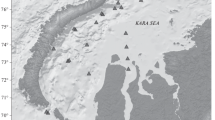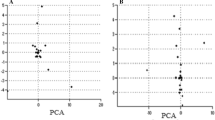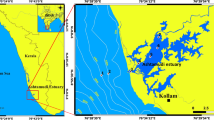Abstract
The proximate chemical composition (ash, soluble carbohydrate, lipid and protein) was determined in 30 common species of tropical Australian marine macroalgae from Darwin Harbour (12∘26′S, 130∘51′E), in summer (hot and wet) and winter (cool and dry). There was a wide diversity of species in both seasons (19 species in summer and 20 species in winter). In most species, the major component was soluble carbohydrate (chlorophytes range 2.5–25.8% dry weight (dw), phaeophytes range 8.4–22.2% dw, rhodophytes range 18.7–39.2% dw) with significantly higher (p < 0.05) percentages only in winter season rhodophytes. Highest percentages of protein were found in rhodophytes collected in the summer (range 4.8–12.8% dw), with significantly lower percentages (p < 0.05) during winter. All species had lipid contents within the range 1.3–7.8% dw, with highest percentages in summer phaeophytes, but no significant differences between species or season. Most species had moderate to high ash contents (24.2–89.7% dw), with the highest percentages during summer. Compared with summer samples, macroalgae collected in winter had higher energy value and slightly lower percentages of inorganic matter. The variation of algal groups and chemical composition may influence the availability of the food source for the majority of herbivores, which in turn is likely to effect their ecology and community structure.
Similar content being viewed by others
References
Abbott IA (1988) Food and food products from algae. In: Lembi CA, Waaland JR (eds), Algae and Human Affairs. Cambridge Univ. Press, Cambridge, pp. 135–147.
Banaimoon SA (1992) Fatty acids in marine macroalgae from Southern Yemen (Hadramout) including occurrence of eicosatetraenoic (20:4) and eicosapentaenoic (20:5) acids. Bot. Mar. 33: 165–168.
Bligh EG, Dyer WJ (1959) A rapid method of total lipid extraction and purification. Can. J. Biochem. Physiol. 37: 911–917.
Brett JR, Groves TD (1979) Physiological energetics. In: Hoar WS, Randall DJ (eds), Fish Physiology Vol. VIII, Academic Press, London, pp. 279–351.
Chapman VJ, Chapman DJ (1980) Seaweeds and Their Uses. Chapman and Hall, London.
Commonwealth Bureau of Meteorology, Australia. 1998. http://www.bom.gov.au/climate/averages/tablesa/cw_014015.shtml
Dubois M, Giles KA, Hamilton KS, Rebers PA, Smith F (1956) Colorimetric method for the determination of sugar and related substances. Anal. Chem. 18: 350–356.
Hawkins SJ, Hartnoll RG (1983) Grazing of intertidal algae by marine herbivores. Oceanogr. Mar. Biol. Ann. Rev. 21: 195–282.
Kaehler S, Kennish R (1996) Summer and winter comparisons in the nutritional value of marine macroalgae from Hong Kong. Bot. Mar. 39: 11–17.
Kumar V (1993) Biochemical constituents of marine algae from Tuticorin coast. Indian J. Mar. Sci. 22: 138–140.
Mercer JP, Mai KS, Donlon J (1993) Comparative studies on the nutrition of two species of abalone, Haliotis tuberculata Linnaeus and Haliotis discus hannai Ino. I. Effects of algal diets on growth and biochemical composition. Invertebrate Reprod. Develop. 23: 2–3.
Renaud SM, Parry DL, Luong-Van T (1994) Microalgae for use in tropical aquaculture I: Gross chemical and fatty acid composition of twelve species of microalgae from the Northern Territory, Australia. J. Appl. Phycol. 6: 337–345.
Renaud SM, Lambridinis G, Luong-Van T, Parry DL, Lee C (1997) Chemical composition of algae for use in Trochus niloticus. studies. In: Lee CL, Lynch PW (eds), Trochus: Status, Hatchery Practice and Nutrition, Australian Centre for International Agricultural Research, Canberra, pp. 88–96.
Renaud SM, Luong-Van T, Parry DL (1999) The gross chemical composition and fatty acid composition of 18 species of tropical Australian microalgae for possible use in mariculture. Aquaculture 170: 147–159.
Robeldo D, Pelegrin YF (1997) Chemical and mineral composition of six potentially edible seaweed species of Yucatan. Bot. Mar. 44: 301–306.
Wong KH, Cheung PCK (2000) Nutritional evaluation of some subtropical red and green seaweeds Part I – proximate composition, amino acid profiles and some physico-chemical properties. Food Chem. 71: 475–482.
Wynne MJ, Luong-Van Thinh J (1997) A report on collections of benthic marine algae from Darwin, Northern Australia. In: Lee CL, Lynch PW (eds), Trochus: Status, Hatchery Practice and Nutrition, Australian Centre for International Agricultural Research, Canberra, pp. 81–87.
Author information
Authors and Affiliations
Corresponding author
Rights and permissions
About this article
Cite this article
Renaud, S.M., Luong-Van, J.T. Seasonal Variation in the Chemical Composition of Tropical Australian Marine Macroalgae. J Appl Phycol 18, 381–387 (2006). https://doi.org/10.1007/s10811-006-9034-x
Published:
Issue Date:
DOI: https://doi.org/10.1007/s10811-006-9034-x




